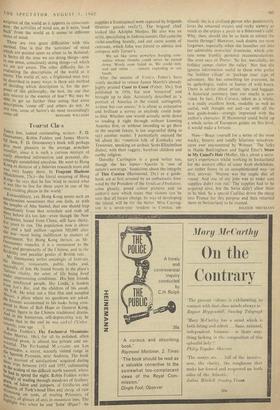World as it Seems
Sketch for a Theory of the Emotions. By
THIS is a translation of a brief work that was published in 1939, and it is an excellent thing that it has appeared. It is of considerable in- terest in its own right, and also serves as 3 comparatively luminous introduction to some of the themes which Sartre pursues more porten- tously in Being and Nothingness. Not all readers may entirely agree with the blurb when it says that the essay 'is nowhere an obscure or difficult work.' but it is true that it has a special briskness and lightness of touch. Sartre starts by criticising three existing theories of emotion—a 'theory of emotion' being a theory about what emotions essentially are- of what distinguishes theM from other psychology cal happenings. The theories criticised are those of William James, that an emotion consists of consciousness of an internal physiological dis- turbance; of Janet, that emotion is 'the behaviour of defeat'; and of certain Gestalt psychologists, that emotion (the example particularly On" sidered is anger) is an escape from tension ex- perienced in trying to 'structure' a recalcitrant environment. Of these theories, Sartre regards the third as better than the second, and the second as better than the first: we are approach- ing. without reaching the truth. He then turns to criticism of psychoanalytic theories, the point of attack being the concePt of the unconscious; this is a theme he has de- veloped in later writings. From this, he moves to his own theory, which occupies the last forty or so pages of the book. The central idea n, this is that emotion is a more primitive state al consciousness or way of seeing the world, the essence of which is that it embodies a belief in magic. The object of a fear, for instance, may be seen as horrible quite independently of any powers for harm it may be believed to have' the fact that the horrible face at the svindfl is on the other side of the window just dis- appears in the state of terror. More basically, the magi-Cal element occurs in the reactions of the man in the emotion: in fear we may faint, and this is a magical waY of seeking to annihilate the object of fear—like, a man faced with a difficult problem who Os," goes to sleep. The account is not supposed I' apply only to negative emotions; with great for genuity, Sartre applies the same ideas to jay. instance, which he identifies as a magical watYe of trying to make simultaneous and come satisfactions incomplete and successive.
As so often with Sartre, I find myself left at
the end dazzled but doubtful. The cleverness_ and imagination are enormous, and sometimes one is convinced. But even where one is, there
is a doubt about what one has been convinced',
of. This doubt goes back to Sartre's met"• b the so-called 'phenomenological' method, wflie he took (with adaptations) from Husserl. „t philosophy of this method is complex and no easy to make clear. Mrs. Mary Warnock, inrne brief but helpful preface to this book, goes °tier way to making it clear, though wonder whet —despite her disclaimers—she has not over' estimated the genuine influence of Descartes °n
:
Sartre. For Descartes, mind or consciousness is
of
something to be investigated independent')iv ,re, the world, by way of reflexion. With Sar` es for whom it is essential that consciousness , not have to be reflexive, that we can exPerte'-er without thinking that we experience, we disenv the activities of consciousness by giving a o, scription of the world as it appears to conscious- ness: the activities of mind are, as it were, 'read back' from the world as it seems in different states of mind.
There are two great difficulties with this method. One is that the 'activities' of mind Which are posited seem so often to be fictional; 10 Sartre all the time we are doing things—and. In one sense, consciously doing things—of which We are not aware. The other difficulty lies in evaluating the descriptions of the world as it Seems. The world of, say, a frightened man may be described in many ways; is there any method of deciding which description is, for the pur- poses of this philosophy, the best, the one that gets nearest to the essence of fear? We may be able, to get no further than seeing that some descriptions 'come off' and others do not. At any rate, some of Sartre's do most resoundingly































 Previous page
Previous page